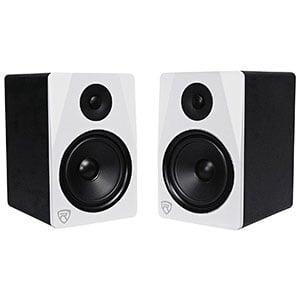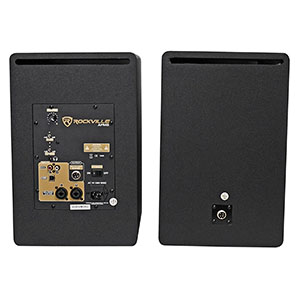- Home
- Instruments
- Gear
- Recording
- Lessons
- Reviews
- Blog
It's no secret that a few well-established brands are dominating the studio monitor market with an emphasis on the affordable range. Even so, Rockville and other underdog competitors are still able to break through. Actually, Rockville's Apm8w is one of the more interesting monitors you can get under $200.

Rockville could have easily gone with an outrageous design for their Apm8w speakers. However, they have chosen the complete opposite. These monitors feature black glossy cabinets paired with white baffle and black drivers. This contrast makes them very attractive without sacrificing any of the inherent simplicity of their design. Build quality is great. This is clear from the abundance of tight tolerances all over the place. Put these next to a much more expensive set and they will blend right in.
Speaking of aesthetics, there are other color choices available. As usual, front of these speakers is very clean while all of the controls are located on the back of the active unit. In other words, more of the same we are used to seeing.

So far, we haven't really seen anything that would sway a potential user to get a Rockville set of monitors over one of the better-known brands. All of that is going to change right about now. First of all, these bad boys pack an 8″ low-frequency driver each. On top of those, we have the standard 1″ tweeter unit that sits in a subtle waveguide.
Rockville Apm8w is an active set with a decent Class D amplifier hidden behind those MDF boards. Here's the kicker. A pair of these will give you 250 Watts of power. That's right, we are well within the proper studio monitor territory here. Keep in mind that those 250 Watts are RMS. Back panel reveals all of the acoustic controls you could wish for, as well as an RCA/USB/TRS/XLR input cluster.
If there is one thing you can expect from a pair of Rockville Apm8w, it is raw power. Let's just say that volume definitely won't be an issue, even if your studio is a larger one. In terms of transparency, these are surprisingly good. We have expected the main drawbacks to transparency related, but that is simply not the case. There is some bias in the lower end, however, trebles and mids are as tight as they come.
The beauty of owning a pair of 8″ low-frequency drivers is that you can really move some air should you want to. With the available controls on the back panel and some smart EQ adjustments on your end, Rockville Apm8w can really be brought to a comfortable level of sound quality. The process of positioning the speakers is the key here. Due to
their larger size, it will require some effort.
Rockville Apm8w may not be the most refined set of monitors in their category, but it sure is among the most powerful ones you can find. Instead of taking the well-known route, Rockville really turned the heat up by challenging the competition with their hardware selection and great versatility.
For more info about the Rockville Apm8w, click here.
For more studio monitors under $200 you might like, click here.

Andre Blackman says
I have a problem with the highs clipping out when i go past just the half way point, Why is that if their 500 watt max.
Ken says
Wattage means nothing if the speakers are not efficient:
90dB SPL 1watt @ 1meter efficiency speaker if fed 50 watts
will be as loud as an
84dB SPL 1watt @ 1meter efficiency speaker if fed 100 watts
If the manufacturer doesn’t display the full specs of the speaker, look them up. Remember, for powered speakers wattage means nothing. Look at max SPL. Higher the number, louder the speaker.
Watts are a measure of power handling capacity, not of loudness. Think number of cylinders in a car vs actual displacement.
Remember a 6dB change in SPL is heard by the human ear as twice as loud/quiet than the original source.
Take the Behringer B2031A with a max SPL of 116 vs the Apm8w at 106 max SPL. The Behringer provides substantially more volume (at least twice as loud which would be 112dB) . The Behringers would be an extra $100 per pair.
The lower end issues mentioned may be from the LF driver composition. Monitors using a polypropylene cone are not as well defined as the newer kevlar or fiberglass composite cones now used in studio monitors (FYI the Behringers use the same material as the Apm8w in their low frequency driver).
Overall, average sound with some coloration but can’t beat the price.